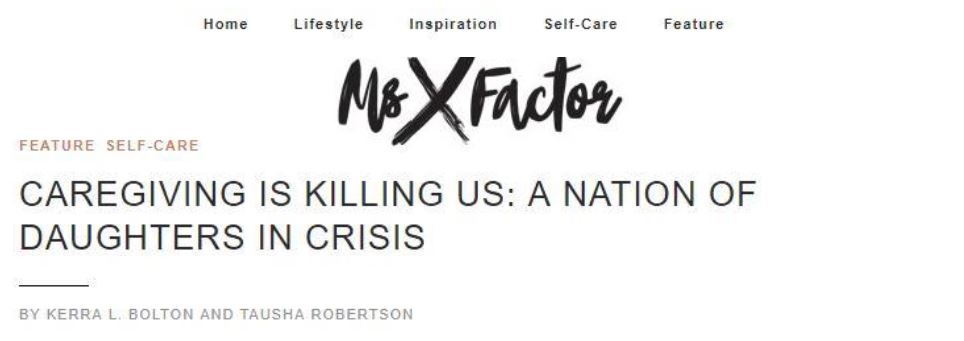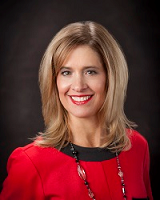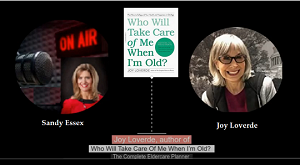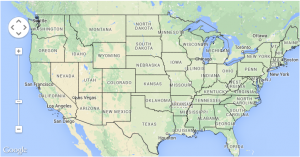Copyright © 2018 Roberson Digital Media, Inc. Page 1 of 5
“Even though I act like I’m tough, I’m really not,” said Carter. “I don’t wear my emotions on
my sleeve. No one knows how tired I am.”
For family caregivers, everything is fine
until it isn’t. One cough, minor medical procedure, or incident of forgetfulness can spiral into
months and years of emergency
department visits, confusion, financial stress, and strained family relationships.
That’s what happened to Yolanda Carter
11 years ago after her mother had knee surgery.
“The hospital called me every five
minutes,” said Carter , 46, of California.
“My mother was trying to break out of the hospital. She went from kind of okay to can’t drive to living in
assisted living in two years.”
Carter initially attributed her mother’s behavior to the ordinary stress of aging. However, signs of
dementia increased as her mother frequently got lost, missed appointments, and grew agitated and
violent.
“You have to constantly watch people with dementia because they want to leave,” Carter said. “I used to
travel for work, but I had to quit my job. Since then, I haven’t been able to find comparable income. I
have had jobs, but I couldn’t have a career anymore.”
While Carter has siblings, they have not taken an active role in their mother’s care. Carter is managing
her mother’s care and raising her daughter with the help of a loving and supportive husband. But
sometimes it all gets to be too much.
Copyright © 2018 Roberson Digital Media, Inc. Page 2 of 5
Photo Credit: www.ml.com
A 2011 MetLife study estimates that female caregivers lose about $324,044 in lost wages
and Social Security benefits.
The Costs of Caregiving Carter is not alone. Roughly 66 percent of all family caregivers are women.
The average caregiver is a 49-year-old woman who works outside the home and provides at least
20 hours a week of unpaid care to her aging parent,
according to the latest data from the Family Caregiving Alliance.
While men are caregivers, women spend as much as 50 percent more time than men in providing care.
Survey data analyzed by Rich Johnson and Josh Wiener at the Urban Institute found that daughters
account for seven out of 10 adult children who help frail parents. Daughters are also five out of every six
adult children responsible for the daily, labor-intensive tasks such as feeding, bathing, and dressing that
keep their parents out of a nursing home bed.
The work may be unpaid, but it doesn’t mean that it’s free.
Women bear significant financial, emotional, and health costs for caring for aging parents, especially if
they are also raising children.
Caregiving has a significant economic impact on the family – whether it’s paying for prescription
medications, installing a ramp for a wheelchair-bound parent, or paying for assisted living home
expenses not covered by Medicare, private insurance, or long-term health insurance.
More money is needed to cover these expenses.
But female, family caregivers often limit their earning potential to take care of frail parents by working fewer hours, passing up job promotions, training and
other assignments that lead to career advancement, taking a leave of absence, or switching from full to
part-time employment.

One four-year study found that women caregivers were nearly six times as likely to suffer depressive symptoms and anxiety
than non-caregivers.
Researchers also found that women caregivers are also more likely to
defer their health needs while caring for others which can lead to
Copyright © 2018 Roberson Digital Media, Inc.
Page 3 of 5
Photo Credit: www.nia.nih.gov
In short, caregiving is killing us. significant decline in their own health.
Well-meaning friends may suggest that we take time out for self-care, but that’s not always possible.
Debra Gibson, 55, of Mississippi cared for her critically ill mother and husband while taking care of two
grandchildren while her youngest daughter worked. On some days, Gibson had no choice other than to
bring her grandchildren to the hospital while she looked after her husband and made a makeshift pallet
on the closet floor for the children to sleep.
“I used to cry every day,” Gibson said. “My break was going outside in the backyard and screaming.
Then, I would get myself back together and go back in the house to take care of my mom.”
Gibson found comfort in her faith to see her through.
However, women caregivers are also at increased risk of: elevated blood pressure and increased risk of
developing hypertension; lower perceived health status; poorer immune function; slower wound
healing; and an increased risk of mortality.
A Constellation of Challenges
Family caregivers face a constellation of
challenges. Among them are care, family, and money.
Care includes managing medications, making decisions, providing day-to-day care, dealing with hospitals and doctors, and finding the right care.
“When you start taking care of your parents, it’s a race against the clock to get the experience and knowledge you need in the shortest amount of time possible so that you don’t run out of energy or
money or both,” said Anne Tumlinson, a health care and public policy expert with 25 years of research
and consulting experience in post-acute and long-term care financing and delivery.
Long-standing family dynamics, especially sibling relationships, become magnified when a parent is
critically ill. It’s often up to the primary family caregiver, who is in most cases the daughter, to figure out
how the family will pay for the cost of care, as well as handle wills, legal issues, Medicaid, and private
insurance.
However, the most significant yet unspoken stressor female, family caregivers face is the expectation
that they will continue to do and be it all.
Copyright © 2018 Roberson Digital Media, Inc.
Page 4 of 5
“I feel like I lost myself in the process,” Fields said. “Now, I’m trying to recover me. (At the
resort) I focused on meditation, being present, and being aware. Every day I take steps to
be more aware and present with my family.”
Photo Credit: AARP.org
Women are still expected to be the perfect mother, wife, and employee while taking care of an elderly
parent who demands more of their attention as their health declines. Black women and other women of
color face additional pressure to live up to expectations of the “strong” one or dutiful daughter who will
take care of everyone without a complaint or thought to her own needs.
“We (women) think we are the greatest multi-taskers,” said Dawna Fields*, 47, of California. Fields’s
mother is in the throes of advanced dementia. “But when it all came to a head, I was not.”
Fields wasn’t sleeping because her mother was up at all hours. Her husband and son felt neglected. She
stopped exercising and experienced back issues. Finally, her husband insisted Fields rest at a resort for a
few days after her recent back surgery.
Creating Our Own Caregiving Path
Women like Carla Davis*, 44, of Texas are creating their own path in family caregiving.
Davis, like most women caregivers, juggled the needs of her ailing father, husband and children, and
professional responsibilities. However, instead of compartmentalizing and straining to please everyone,
she learned to prioritize, communicate, and integrate her own needs.
“At different times in your life there are different priorities,” she said. “Everyone involved needs to come
to terms with that.” If there was no immediate need, Davis told her father she couldn’t see him immediately when the children had a basketball game, or she had to meet a work deadline. Davis didn’t hide the eventuality of her father’s passing from her children when his health deteriorated, and he came to live with them.
“Keeping those things separate is a recipe for 
driving yourself crazy,” she said. “For our family, it was better for us to be together and go through it together.”
Davis’ father also communicated his advanced care and other wishes long before his passing in August so there would be no bitterness between Davis and her siblings.
“He wanted me and my brothers to be close and for there to be harmony during his illness and after,” she said. “After his father died, there were fractures with his brother and sister, who didn’t
Copyright © 2018 Roberson Digital Media, Inc.
Page 5 of 5
“Taking care of a loved one is not a solo event,” she said. “It’s a team event. Look at everything, not through the lens of ‘how can I get this done?’ but rather ‘who can help me get this done?’”
speak to each other over estate matters. He made sure it didn’t happen to us. We are honoring his wishes.” Search for Solutions Many families aren’t so lucky. However, there are industry, policy, and community support for female caregivers.
Integrity Home Care and Hospice in Missouri, for example, provides a nurse or social worker at no charge to help families navigate the increasingly complex health care system. They also provide respite care at an hourly rate to help caregivers handle burnout, and advocate at the state legislature for laws that keep caregiving affordable and manageable for families. Brandon Rachal,
Executive Director of Education and Organizational Development at Integrity Home Care, also advises health care providers to take a culturally-competent approach to helping family caregivers. “Depending on their geographic location, home care agencies have to make a point to understand diversity and inclusion when it comes to understanding how various cultures receive care in the health system,” Rachal said. “Historic context may prevent people from seeking care.”
On a national level, Tumlinson said things might have to get worse before they get better. Within the next decade, the country could see a crisis in which there are more aging adults and fewer daughters to take care of them. “We are operating in a system that is broken,” she said. “We don’t have a system for financing long-term care and will protect us against the financial devastation that occurs when you get a diagnosis of Alzheimer’s, Parkinson’s or something that requires a lot of care but doesn’t get covered under insurance.” In the meantime, women shouldn’t continue to suffer in silence. Tumlinson founded Daughterhood, a national organization that helps local leaders create community circles to help female family caregivers navigate the emotional, financial, and technical challenges.
“If you’re a mom, it’s easier to connect with other moms,” she said. “It’s hard to find other caregivers.” Tumlinson also recommends women caregivers “say no to non-essentials, stand up to authority, and let go of the outcome.” *Names changed to protect family privacy
To take the next step, You can contact me from my info listed below or you can fill out this form for a call back,
I look forward to helping you.
Sandy Essex,
CLTC Long Term Care Planning Advisor
847.695.6690
Visit us at www.BestLtcAdvice.com
CLICK HERE to see the COST Of CARE IN YOUR AREA
To send me a Secured Email click here!
We take care of tomorrow, so you can focus on today!







